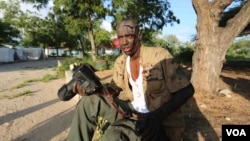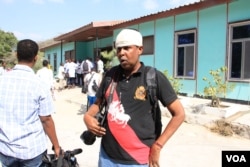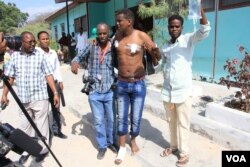On Wednesday, January 25, events in Mogadishu showed again why the Somali capital might be the most dangerous city in the world for journalists.
Reporters had rushed to the Dayah Hotel after al-Shabab militants detonated a truck bomb at the hotel's main gate and then stormed the premises, exchanging gunfire with security guards. The entire façade of the five-story hotel had been ripped away, and bodies littered the street.
The reporters were interviewing rescue workers and surveying the damage when a second vehicle bomb went off, 15 minutes after the first. Seven journalists suffered shrapnel wounds. One, a reporter for French news agency AFP, was taken to a local hospital with life-threatening injuries and remained there as of Monday.
Sustaining injuries during explosions and attacks by al-Shabab is a common experience for journalists working in Mogadishu. Al-Shabab, which is attempting to overthrow Somalia's federal government, regularly attacks the capital's hotels, which are gathering spots for officials, parliamentarians and government-connected business people.
Most of the reporters are freelancers, with no security to protect them and no health benefits if they are injured on the job.
Feisal Omar, a photographer for the Reuters news agency, says journalists charge into a dangerous situation anyway.
“When things happen, freelance journalists are the first to arrive at the scene only with cameras. The place we are arriving at is very hostile, explosions can target us, we can be caught in the crossfire, and we can be arrested by government security agencies because of the pictures we shot,” Omar said. “We are like first responding unarmed soldiers.”
In 2011, Omar was one of three Reuters photographers who won awards at the 54th annual World Press Photo contest. Two years later, in November 2013, he was injured in an explosion at Mogadishu's Sahafi hotel.
‘Operating with indefinite death sentence’
Six of the journalists injured Wednesday were working on freelance contracts with major news agencies and television networks , among them AFP, the Associated Press, Al-Arabia and Al Jazeera television.
One of them was photojournalist Farah Abdi Warsame of AP. He took second prize in the General News Stories category of the 2010 World PressPhoto contest. His photo showed a young man being stoned to death by Somalia's al-Shabab militants.
Abdi, 45 and a father of three, said he and his fellow freelance journalists are on alert every day, 24/7, to rush to where the news breaks, and many times they themselves become part of the headlines.
Wednesday marked the second time he was injured covering the news.
“In July 2016, I was also among several journalists hurt in a press conference bombing in Mogadishu,” he said. “It is like operating with an indefinite death sentence.”
Abdi said he knows the danger he faces when he leaves home every day, but has good reason to sacrifice.
“Knowing the risks and the fact that I want to show the world the outrage and sometimes positive things happening in my country, I rush to everywhere the news breaks, regardless of the risks surrounding me,” he told VOA's Somali service. “I must also take care of my three kids.”
Another journalist injured on Wednesday was Abdulkadir Zubeyr, a cameraman with the Al Arabiya news channel. In December 2009, his older brother, Hassan Zubeyr, who was also a cameraman for Al-Arabiya, was one of 25 people killed in the bombing of a graduation ceremony at the Hotel Shamo in Mogadishu.
"I took the job after my brother died to take care of his kids and the family." Zubeyr said. "I knew the risk."
The exploitation of freelancers
According to the Committee to Protect Journalists, which has documented journalists' deaths worldwide, 62 have been killed in Somalia since 1992. In some cases, al-Shabab has murdered journalists for what the group considered unfriendly reporting, or for alleged collaboration with the government.
Many of the deaths, however, occurred while journalists were trying to take pictures or gather information for a story.
Mohamed Ibrahim Moalimuu, secretary-general of the National Union of Somali Journalists, who previously worked with the BBC and Reuters, said more than 100 freelance journalists are working with foreign media outlets, risking their lives daily in Mogadishu.
“In a country, where 70 percent of the population is under the age of 30 and [there is] 75 percent unemployment, the result is that very young, inexperienced freelance journalists risk their lives for survival,” Moalimuu said. “They depend on photography to make a living.”
He says media companies exploit them and buy their material for less than $60 regardless of the story, the quality and the danger they go through to garner them.
“They get no training, safety instructions, safety equipment or insurance, and they report from combat zones in Somalia, one of the world's most dangerous places, and unfortunately they do not get benefits equivalent to their materials and dedications,” Moalimuu said.
“They are cheap labor in a dangerous zone, and receive no proper treatment from the editors at the companies they work with, who mostly likely sit in very peaceful offices in Nairobi. A lack of experience, combined with a lack of money and respect, can be deadly for journalists in war zones.”
Abdullahi Olad Roble, Somalia's deputy minister of information, said he has warned journalists to be careful.
“I know journalists like to tell the story, and I think all of them know (that) no story is worth dying for. Please, try not to rush to the battle zones and attack scenes because that only increases the chance of you dying in explosions, crossfire and terrorist booby traps," Roble said.
He accused international and local media outlets of thrusting inexperienced young journalists into tragic circumstances.
“Most of the active video- and photojournalists whose work appears on the Somalia international headlines do not get the necessary hostile environment training they need. And the news outlets they work for push them to put themselves in harm's way to report first-hand," he said.










